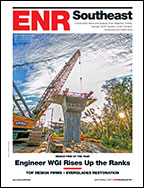Builders of mass transit systems seem cautiously optimistic about the future, buoyed by steady ridership figures and the recent rally to overcome threats to dedicated funding.
Despite a sluggish economy, public transit ridership continues its steady growth in the U.S., increasing by 5% in the first quarter of 2012 over the same time period in 2011 and representing the fifth consecutive quarter of growth, according to the American Public Transportation Association (APTA).
While high gas prices are a factor, APTA officials note that 60% of the trips are for regular commutes, indicating a more consistent kind of use. "We see record ridership on public transit systems throughout the country. In some regions, the local economy is rebounding and people are commuting to their new jobs by using public transportation," says APTA President and CEO Michael Melaniphy.
He spoke at APTA's annual rail convention, held in Dallas on June 2-7. That city boasts the country's biggest light-rail system, at 72 miles. Construction is ongoing on extensions that will increase the total to 96 miles. Dallas Area Rapid Transit officials said related land developments are worth $8 billion.
DART President and APTA Chairman Gary Thomas said transit construction continues throughout the country, "even as Congress continues to debate the federal transportation reauthorization bill.
He also praised the industry for its quick rally in the face of the "assault" by the House Ways and Means Committee on mass transit funding in February. The proposal would have diverted $25 billion in fuel-tax revenue from transit.
APTA immediately put together a webinar and, within days, had gathered 35 pages of signatures from various groups in opposition, Thomas noted, saying, "That helped reverse the proposal within days."
However, warned Thomas Waldron, senior vice president with AECOM's transportation group, "There will be many more battles to come, so get ready."
Joseph Szabo, Federal Railroad Administration chief, invoked Dwight D. Eisenhower's launch of construction of the interstate system. "Through eight recessions, we built the best highway system in the world," he said. "When future generations look at us, will they say we got it right?"
Noting that the presidential budget for 2013 requests $8.5 billion for intercity and high-speed rail, Szabo said, "I'm convinced that one day we will have a true 21st-century rail network."



